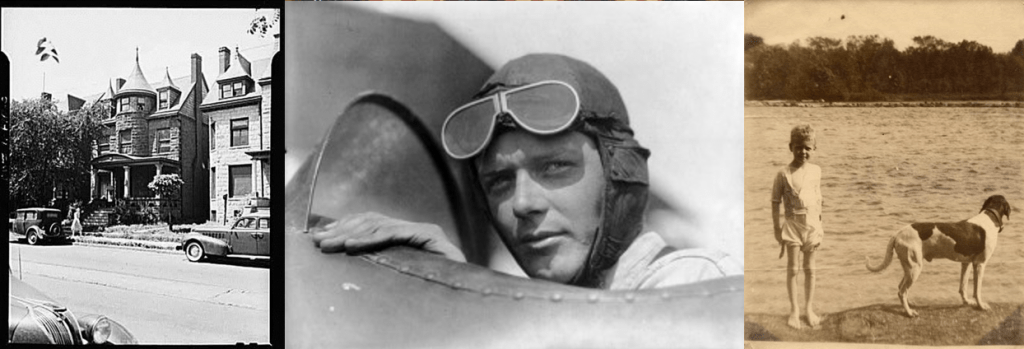Charles Lindbergh’s Connection to Detroit
This current Wayne State Housing building stands on the site where the famous aviator Charles Lindbergh was born on February 4, 1902. The home at 1120 W. Forest Ave. in Detroit actually belonged to his grandfather, Dr. Charles H. Land, a dentist and inventor, but it was torn down in 1973 and the current building was erected on the same site. His mother, Evangeline Lodge Land Lindbergh, was an extraordinary woman for her time. She had a degree in chemistry from the University of Michigan and taught science at Cass Technical High School in Detroit. His father, Charles Augustus Lindbergh Sr. was a Swedish immigrant. His father, August, served in Sweden’s parliament, but became frustrated with their rigid class system and moved to America. Charles Sr. eventually rose in prominence in politics as well and served in the United States Congress for a decade.
Charles Sr. and Evangeline separated when Lindbergh was a young child and he spent most of his youth splitting time between Little Falls, Minnesota and Washington D.C., although he spent a few weeks in Detroit with his grandfather every year in the spring and in the fall. His grandfather encouraged Lindbergh to be curious and exposed him to the scientific method and the two performed experiments together in the basement of the house on this site.
Of course, Lindberg is most well-known for his flying. He rose to fame with his non-stop cross-Atlantic flight from Long Island to Paris in his single-seat monoplane Spirit of St. Louis. He left on May 20th, 1927 and landed 33 hours later on May 21, 1927. He became famous overnight. Lindbergh used his fame to promote AirMail services and commercial airfare in the Americas.
Sadly, his fame also led to a great tragedy for his family in the “Crime of the Century.” Lindbergh’s first child Charles Lindbergh Jr. was abducted from the Lindbergh home at only 20 months old on March 1, 1932. Although the Lindberghs negotiated with the kidnappers and paid out $50,000, the child was found dead by the side of the road six weeks after the payment. The cash was traced to a German immigrant by the name of Bruno Hauptmann in the Bronx. In spite of doubts that Hauptmann could have acted alone, Hauptmann was convicted and executed for the crime on April 3, 1936.
Following the tragedy, Lindbergh moved his family to Europe to escape the press and attention and protect his second-born son, Jon. The family lived mostly in a small village in Kent but traveled extensively. Lindbergh eventually had a total of six children with his wife Anne Morrow Lindbergh, four boys and two girls. In addition, Lindbergh had at least five children out of wedlock with two German sisters in Bavaria, Marietta and Brigitte Hesshaimer. He also had two children by his European secretary, Valeska, an East Prussian aristocrat, who had been friends with the Hesshaimers, before learning of his affairs with them as well.
While in Europe, Lindbergh gave talks in Germany on aviation and toured German aviation facilities. He was infamously awarded a medal for this service by Adolf Hitler in 1938. This caused some controversy, but Lindbergh refused to return the medal. Although Lindbergh was a believer in Eugenics and the superiority of the European race, he was repulsed by the barbarism of Kristallnacht in November of 1938 and put off a planned move to Berlin. He returned to the United States the following year and settled in Long Island. Although initially anti-war, as was his father before World War I, Lindbergh flew many combat missions in the Pacific during World War II.
In his later years, Lindbergh was an author and explorer. He lived his final years in Maui, Hawaii. On August 26, 1974, Lindbergh died of lymphatic cancer at the age of 72. Following his request, he was buried in his work clothing: his favorite plaid shirt, khaki pants and a Hudson’s Bay blanket he had once brought from Canada for his mother.

Bibliography
Charles A. Lindbergh Sr. [photograph]. (n.d.). Retrieved January 30, 2014, from beyondtheriversofethiopia.blogspot.com/2012/05/mundus-vult-decepi-deceptimur-world_19.html
Charles Lindbergh and His Dog, Spot, by the Mississippi River [photograph]. (1910). Retrieved January 30, 2014, from shs.umsystem.edu/historicmissourians/name/l/lindbergh/index.html
Charles Augustus Lindbergh and Charles Augustus Lindbergh, Sr [photograph]. (1910). Retrieved January 30, 2014, from charleslindbergh.com/history
Charles Lindbergh Sr. [photograph]. (n.d.). Retrieved January 30, 2014, from shs.umsystem.edu/historicmissourians/name/l/lindbergh/index.html
Evangeline Lodge Land Lindbergh [photograph]. (1899). Retrieved January 30, 2014, from findagrave.com/cgi-bin/fg.cgi?page=gr&GRid=9347679
Giblin, James Cross. Charles Lindbergh: A Human Hero. New York: Houghton-Mifflin, 1997. Print. Lindbergh Baby Poster [photograph]. (1932). Retrieved January 30, 2014, from en.wikipedia.org/wiki/Lindbergh_kidnapping
Noble, John M. Charles Lindbergh, Wearing Helmet with Goggles Up [photograph]. (1923). Retrieved January 30, 2014, from commons.wikimedia.org/wiki/File:Charles_Lindbergh,_wearing_helmet_with_goggles_up.jpg
The Phreezound Orchestra. “Transcendental Doorbell.” The Phreezound Orchestra [online recording]. (2013). Retrieved January 27, 2014, from freemusicarchive.org/genre/20th_Century_Classical
Schröck, Rudolf. Das Doppelleben des Charles A. Lindbergh. Munich: Heyne Verlag, 2005. Print.
[Untitled photograph of Charles Lindbergh]. (n.d.). Retrieved January 30, 2014, from biography.com/people/charles-lindbergh-9382609
[Untitled photograph of Charles Lindbergh in Mail Plane]. (n.d.). Retrieved January 30, 2014, from fiddlersgreen.net/models/aircraft/Boeing-Monomail.html
[Untitled photograph of Charles Lindbergh in front of Spirit of St. Louis]. (1927). Retrieved January 30, 2014, from simpsonstreetfreepress.org/history/charles-lindbergh
[Untitled photograph of Charles Lindbergh in front of Spirit of St. Louis]. (1927). Retrieved January 30, 2014, from charleslindbergh.com/plane
[Untitled photograph of Dr. Charles Henry Land]. (1905). Retrieved January 30, 2014, from findagrave.com/cgi-bin/fg.cgi?page=gr&GRid=9347174
[Untitled photograph of Lindbergh baby and killer]. (1932). Retrieved January 30, 2014, from content.time.com/time/specials/packages/article/0,28804,1937349_1937350_1937351,00.html
